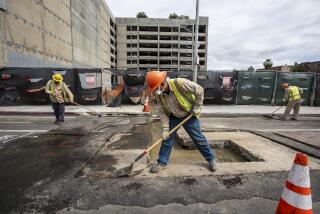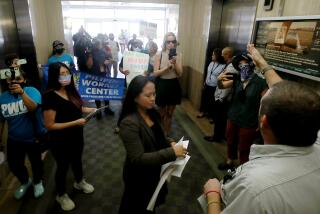Risks Are Part of a Day’s Work
A late-model black Lexus pulls up and is quickly surrounded by several men. Raising his index finger, the driver indicates that the job requires just one. The worker who reaches the car first is motioned in; the transaction takes less than a minute.
Where he will go, what kind of work he will do, how much -- or if -- he will get paid, the worker knows not. For the day laborer, as well as the employer, uncertainty is part of the underground labor market. Usually Spanish-speaking and marked by well-worn, often paint-splattered clothes, the men who work as day laborers can be found outside home-improvement stores, small convenience stores and on busy street corners.
Last month, two men offering work picked up day laborer Miguel Carmona in Westminster. Police say the two brothers, William and Stephen Martinez, took Carmona to a storage unit in Huntington Beach and beat him, saying he had stolen property and demanding it back -- an allegation Carmona denies.
The lawyer representing William Martinez says that the unit is the brothers’ office and that what started off as a meeting to ask for the return of stolen property got out of hand.
The brothers have been charged with false imprisonment, kidnapping, second-degree robbery and making criminal threats. They pleaded not guilty and are due in court next week for a pretrial hearing.
While what is alleged to have happened to Carmona is an extreme case, abuse by employers is not uncommon, say workers, advocates for the laborers and city officials.
“For day laborers, the abuse is part of the employment agreement,” says Antonio Bernabe, lead coordinator for the day laborer project at the Coalition for Humane Immigrant Rights of Los Angeles. “If you don’t go to work because the conditions aren’t right, there’s always another [person] jumping in the truck.”
Bernabe says that because there are an estimated 125 corners in Los Angeles County where day laborers congregate -- many of whom are believed to be in the country illegally -- employers can go from one place to another abusing or ripping off workers, with little chance of seeing them again.
At a site in Anaheim, workers exchange stories like troops showing off battle scars. Speaking in Spanish, nearly all recount sad, scary or just plain strange dealings with employers.
Daniel Tomas said he and another man were hired by a woman to help the family move.
When she discovered that her purse was missing, the woman’s husband returned to the site and took the workers to a police station. They were soon released, Tomas says, for a lack of proof.
“They blame you for anything ... something missing, we’re blamed,” says Tomas.
A worker from Guerrero, Mexico, recounted the time he received $160 for seven full days of work.
“The owner didn’t like the way the work was done,” says Faustino Molina, 35, who was hired by a subcontractor. ‘The guy says, ‘If I lose, so do you,’ ” said Molina, who was paid by check.
“And checks always bounce or the accounts end up being closed,” chimes in Tomas.
Molina’s bad luck is well known at the Anaheim site.
“Tell him about the time you loaned that guy money and he didn’t give you that money [back] and didn’t pay you at the end of the day!” shouts a worker.
Embarrassed, Molina admits that, yes, he once loaned a contractor money for landscape supplies, worked a 15-hour day and ended the day $100 down.
For years, advocacy groups and consulate officials have frequented day laborer hangouts, passing out literature informing workers of their rights. The handouts include a spot for workers to record the license plate and address of the contractor’s car and work site, and hours worked.
Still, whether it’s because they lack legal status or they don’t know where to go, few workers take action after a labor violation. Neither the state nor Orange County keeps records on the number of wage claims filed by day laborers.
Job centers provide a meeting point for contractors and laborers. The Costa Mesa Job Center, which opened in 1988, draws between 100 and 130 workers each morning. As many as 40 receive work, said Mark Taylor, management analyst of administrative services for the city. That number has remained relatively constant since the center’s opening.
“Over my time here I’ve personally talked to five to seven cities that have wanted to learn more about the center,” Taylor says. “More cities are realizing that day laborers are not just going to go away. It’s not a perfect solution, but it is a way to work with the community.”
Centers in North Hollywood, Harbor City and downtown Los Angeles offer more than just a stop where contractors meet workers. They provide information on worker rights and English classes. Three more are scheduled to open in Los Angeles County this year. Orange County politicians have been more reluctant to spend money on such centers or programs. In Orange County, “people don’t really see the benefits or values,” says Abel Valenzuela, director of the UCLA Center for the Study of Urban Poverty. Many people wish the workers “would just disappear,” he says.
Though the Building Industry Assn. of Southern California did not return calls about contractors’ dealings with day laborers, its website warns builders that knowingly hiring undocumented or falsely documented workers could lead to fines, prison sentences or civil suits. It also lists resources to help Spanish speakers reduce injuries on the job.
It’s important, said Valenzuela, to educate politicians and the community about what the workers face, as well as let the laborers know how to protect themselves.
The workers will be around as long as there are jobs, he says. “If there wasn’t any work, they wouldn’t be out there looking for it.”
More to Read
Sign up for Essential California
The most important California stories and recommendations in your inbox every morning.
You may occasionally receive promotional content from the Los Angeles Times.










